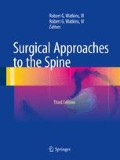Abstract
The anteromedial approach is an extension of the Smith–Robinson approach. It is medial to the sternocleidomastoid muscle and medial to the carotid sheath. This method allows exposure from C1 to T21 and can be combined with an osteotomy of the sternoclavicular joint to allow a greater exposure at T2. The thoracic duct must be avoided with the left anteromedial approach. The recurrent laryngeal nerve should be identified with the right-side approach. The inferior thyroid artery and vein may need ligation, and the apex of the lung must be avoided.
You have full access to this open access chapter, Download chapter PDF
Similar content being viewed by others
Keywords
- Cervicothoracic Junction
- Smith-Robinson Approach
- Sternoclavicular Joint
- Carotid Sheath
- Inferior Thyroid Artery
These keywords were added by machine and not by the authors. This process is experimental and the keywords may be updated as the learning algorithm improves.
The anteromedial approach is an extension of the Smith–Robinson approach. It is medial to the sternocleidomastoid muscle and medial to the carotid sheath. This method allows exposure from C1 to T2 [1] and can be combined with an osteotomy of the sternoclavicular joint to allow a greater exposure at T2. The thoracic duct must be avoided with the left anteromedial approach. The recurrent laryngeal nerve should be identified with the right-side approach. The inferior thyroid artery and vein may need ligation, and the apex of the lung must be avoided.
The anterolateral approach to the cervicothoracic junction is an extension of the Hodgson approach [2] combined with the Nanson supraclavicular approach [3], in which the sternocleidomastoid is removed from the clavicle. The spine is approached from the right side, lateral to the carotid sheath and vessels. With the carotid sheath and internal jugular vein retracted medially, the anterior scalene muscle may be divided and the phrenic nerve retracted for greater exposure.
The 3rd rib resection allows good exposure to T1–T3. When there is a thoracic kyphosis deformity, exposure of C6–T3 is possible [4]. The morbidity associated with dividing the scapular muscle attachments can be significant. The operating space can be enhanced by removal of both the 2nd and 3rd ribs.
By cephalad extension of the posterior proximal limb of the 3rd rib incision, cutting the rhomboid and trapezial attachments to the scapula and sweeping the scapula laterally, the 1st, 2nd, 3rd, and 4th ribs can be removed for maximum exposure. One rib, usually the 3rd, is left to support the scapula [5].
Although the axillary approach has very limited exposure, it does allow biopsy of the T1–T3 area and limited spinal work. The morbidity associated with dividing the pectoralis major is less than that occurring when dividing the scapular muscle attachments.
References
Riley L: Surgical approaches to the anterior structures of the cervical spine. Clin Orthop 91(16):10–20, 1973.
Hodgson AR, Yau ACMC: Anterior surgical approach to the spinal column. In Apley AG (ed): Recent Advances in Orthopaedics. Baltimore, Williams & Wilkins, 1964, pp 289–323.
Nanson EM: The anterior approach to upper dorsal sympathectomy. Surg Gynecol Obstet 104:118–120, 1957.
Perry J: Surgical approaches to the spine. In Pierce D, Nichol V (eds): The Total Care of Spinal Cord Injuries. Boston, Little, Brown, 1977, pp 53–79.
Dawson E: Personal communication.
Author information
Authors and Affiliations
Editor information
Editors and Affiliations
Rights and permissions
Copyright information
© 2015 Springer Science+Business Media New York
About this chapter
Cite this chapter
Watkins, R.G. (2015). Cervicothoracic Junction. In: Watkins, III, R., Watkins, IV, R. (eds) Surgical Approaches to the Spine. Springer, New York, NY. https://doi.org/10.1007/978-1-4939-2465-3_12
Download citation
DOI: https://doi.org/10.1007/978-1-4939-2465-3_12
Publisher Name: Springer, New York, NY
Print ISBN: 978-1-4939-2464-6
Online ISBN: 978-1-4939-2465-3
eBook Packages: MedicineMedicine (R0)




